N-BK7平凸レンズ、コーティング無し
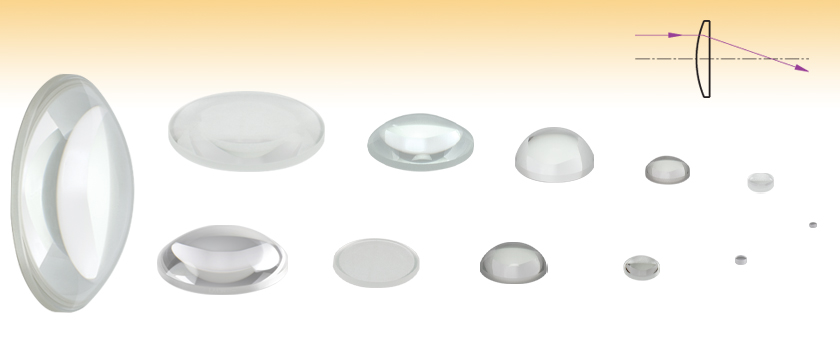
- Positive Focal Length and Near Best Form for Infinite Conjugate Applications
- Many Thorlabs Lenses Available in Zemax Catalog
LA1470
(Ø6 mm)
LA1576
(Ø9 mm)
LA1540
(Ø1/2")
LA1859
(Ø18 mm)
LA1229
(Ø1")
LA1417
(Ø2")
LA1238
(Ø75 mm)
LA1274
(Ø30 mm)
LA1252
(Ø25 mm)
LA1039
(Ø3 mm)
LA1024
(Ø2 mm)
LA1385
(Ø1.5")

Please Wait
| Table 1.1 Common Specifications | ||
|---|---|---|
| Diameters | 2 mm and 3 mm | 6 mm, 9 mm, 1/2", 18 mm, 25 mm, 1", 30 mm, 1.5", 2", and 75 mm |
| Lens Shape | Plano-Convex | |
| Substrate Material | N-BK7 (Grade A)a | |
| Wavelength Range | 350 nm - 2.0 μm (Uncoated) | |
| Design Wavelength | 587.6 nmb | |
| Index of Refraction | 1.515c | |
| Surface Flatness (Plano Side) | λ/2c | |
| Spherical Surface Powerd (Convex Side) | 3λ/2c | |
| Surface Irregularity (Peak to Valley) | λ/4c | |
| Surface Quality | 60-40 Scratch-Dig | 40-20 Scratch-Dig |
| Thickness Tolerance | ±0.03 mm | ±0.1 mm |
| Diameter Tolerance | +0.00 / -0.02 mm | +0.0 / -0.1 mm |
| Centration | ≤ 5 arcmin | < 3 arcmin |
| Abbe Number | vd = 64.17 | |
| Clear Aperture | > 90% of Diametere | |
| Focal Length Tolerance | ±1% | |
| 下の型番横の赤いアイコンをクリックすると、各製品のZemaxファイルをダウンロードいただけます。また、こちらからはすべてのZemaxファイルの一括ダウンロードが可能です。 |
特長
- 材質: N-BK7
- 波長範囲: 350 nm~2.0 μm (コーティング無し)
- コーティング無しと 5種類の広帯域ARコーティング付きでご用意
- 焦点距離4~2500 mm
このコーティング無しの平凸レンズは、RoHS対応のBK7ガラス(N-BK7)製です。N-BK7は通常、UV溶融石英の利点(UVに対しての高い透過率や低い熱膨張係数)を必要としない場合に使用されています。レンズは正の焦点距離を持ち、無限および有限共役用途ではベストフォームに近い形状となります。
平凸レンズは、コリメートしたビームを後方焦点へ集光したり、点光源からの光をコリメー トするのにお使いいただけます。 球面収差を最小に抑えるためには、集光の際にはコリメート光源をレンズの曲面から入射する必要があります。また、コリメートする際には点光源を平坦な面に入射する必要があります。
レンズの焦点距離は、厚レンズ用の下記の公式を使って計算できます。
f = R /( n -1),
ここでnは屈折率で、Rはレンズ面の曲率半径です。これらのレンズはアッべ数64.17のN-BK7製です。アッベ数は分散の指標です。
こちらのN-BK7 平凸レンズはコーティング無しの製品と、レンズの各表面からの反射光を減少させる5種類の反射防止コーティング(-A、 -AB、-B、-Cまたは-D)のうちのいずれかをコーティングした製品をご用意しております(Table 1.2のリンクからご覧いただけます)。コーティング無しの基板では入射光の約4%が各表面で反射し、損失となるため、ARコーティング付きの平凸レンズは特に複数の光学素子を使用する用途で有効です。ARコーティングはとりわけ低光量の用途においては重要で、また複数の光学素子による反射の影響(ゴーストイメージなど)を防ぎます。両面にARコーティングが施されている光学素子は、特に複数の光学素子を用いる用途では必要性が高くなります。コーティングに関する詳細は「グラフ」のタブを参照ください。
これらのレンズの取付け用に固定式レンズマウント もご用意しております。曲率の大きいレンズを取り付ける際にスパナレンチ用に隙間を作る、SM05、SM1、SM2ネジ付きの厚型固定リングもご用意しています(詳細は「取付けオプション」タブをご参照ください)。
当社では、N-BK7レンズキットも販売しています。詳細はこちらをクリックしてご覧ください。
| Table 1.2 N-BK7 Plano-Convex Lens Selection Guide | |
|---|---|
| Unmounted Lenses | Mounted Lenses |
| Uncoated | Uncoated |
| -A Coating (350 - 700 nm) | -A Coating (350 - 700 nm) |
| -AB Coating (400 - 1100 nm) | -AB Coating (400 - 1100 nm) |
| -B Coating (650 - 1050 nm) | -B Coating (650 - 1050 nm) |
| -C Coating (1050 - 1700 nm) | -C Coating (1050 - 1700 nm) |
| -D Coating (1650 - 3000 nm) | - |
カスタムコーティングにも対応いたします。詳しくは当社へお問い合わせください。
| Quick Links to Other Spherical Singlets | ||||||
|---|---|---|---|---|---|---|
| Plano-Convex | Bi-Convex | Best Form | Plano-Concave | Bi-Concave | Positive Meniscus | Negative Meniscus |
Figure 2.1ではRoHS対応のBK7ガラスから作製されたN-BK7レンズの透過率曲線がご覧いただけます。サンプルは10 mm厚、ARコーティング無しで表面反射を含んだ透過率を示しています。N-BK7平凸レンズは、コーティング無しタイプと 350~700 nm (-A)、400~1100 nm (-AB)、650~1050 nm (-B)、 1050~1700 nm (-C)または1.65~3.0 µm (-D)の広帯域ARコーティング付きタイプからお選びいただけます。
こちらの高性能の多層ARコーティングの平均反射率は、仕様波長範囲において0.5%未満(1面あたり)です(ただしABならびにDコーティングでは1.0%未満)。また、入射角0°~30°(NA 0.5)において優れた性能を発揮します。下のグラフは、当シリーズ製品の標準的なコーティングの波長特性を示しています。広帯域ARコーティングの典型的な吸収率は0.25%ですが、この反射率のグラフには反映されていません。
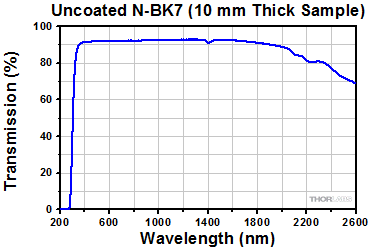
Click to Enlarge
Click Here for Raw Data
Figure 2.1 のグラフはN-BK7ガラス(RoHS準拠BK7ガラス)の透過率曲線です。
この曲線は厚さ10 mmのコーティングされていないサンプルの全透過率を表しており、表面反射の影響も含んでいます。
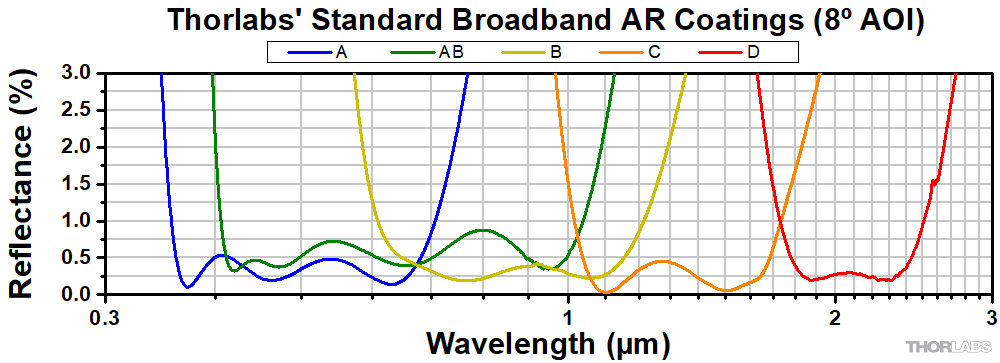
Figure 2.2 当社の標準的な広帯域ARコーティングの反射率(入射角8°)
はじめに
当社では、単レンズが当社基準および仕様に適合していることを確認するため、一連の品質管理を実施しています。この品質管理にはレンズのイメージング機能の工程内検査や、表面品質およびサイズの最終検査が含まれます。各製品の仕様は赤いアイコン![]() をクリックするとご覧いただけます。ここでは、品質検査の一般的なプロセスについて説明しています。
をクリックするとご覧いただけます。ここでは、品質検査の一般的なプロセスについて説明しています。
単レンズの品質管理
単レンズが仕様通りに成形された後、工程内検査が行われます。MIL-PRF-13830B(下記参照)に準じたレベルVIの抜き取りを行い、焦点距離、イレギュラリティ、表面指数(Surface Power)を検査します。この3つの仕様は適正なイメージングを行う際に不可欠です。部品のイレギュラリティは、単レンズの素材にもよりますが、633 nmにおいて1/4波長または1/2波長以下を維持しています。Table 3.2のグラフは単レンズの前面および裏面のイレギュラリティを200バッチにわたって測定したデータです。
この時点で、コーティング無しの単レンズとして最終検査に進むものと、反射防止(AR)コーティングが施されるものに分かれます。光学コーティングについては個別の工程内検査が実施されます。ARコーティングが適正に施されていることを確認するために、分光光度計を用いてコーティングサンプルの反射率および透過率を測定します。その際使用する厚さ2 mmのコーティングサンプルは、同ロット内の部品と同じ素材にします。反射率を測定する場合、コーティングのロットごとに最低1個のサンプルを使用します。透過型の光学素子は前面と裏面それぞれにARコーティングが施されるため、透過率の検査にも両面にコーティングが施されたサンプルを1個使用します。大量のロットでは、複数のサンプルを使用して蒸着チャンバの均一性を確認します。ロットごとにコーティング性能を検査することで、経時的な変化を少なく維持することができます。コーティングの変化についてはTable 3.1をご覧ください。
コーティング無しおよびARコーティング付きの単レンズの最終検査では、表面品質や面取り角、開口が仕様書の記載と合致していることを確認するために、外径および厚さのバッチ検査や全数目視検査などが実施されます。表面品質は最表面の検査ですが、表面にスクラッチ&ディグおよびその他の含有物があると、単レンズを高出力光源と一緒に使用した場合に損傷を受けやすくなります。これらの検査はMIL-PRF-13830Bの要件に合った、クリーンで照明の薄暗い部屋で実施されます。薄暗い部屋で1つの光源だけを用いて試験を実施することにより、ガラス内部のムラが光沢や反射によって不明瞭にならずに見つけやすくなります。
MIL-PRF-13830B:光学部品の性能仕様
MIL-PRF-13830Bは、ARDEC(the U.S. Army Armament Research, Development and Engineering Center)のDefense Quality and Standardization Officeによる、光学部品の製造、組み立ておよび検査の仕様に関する文書です。もともとは、米軍で使用されている製品を装備に組み込むための規格でしたが、数多くの光学メーカによって採用されるようになりました。資料のコピーをダウンロードするには、こちらをクリックしてください。
| Table 3.1 Coating Variances | Table 3.2 Singlet Irregularity | ||||
| -A Coating 350 nm to 700 nm | -B Coating 650 nm to 1050 nm | -C Coating 1050 nm to 1700 nm | |||
| Coating Variance: Transmission |  Click to Enlarge |  Click to Enlarge |  Click to Enlarge |  Click to Enlarge | |
| Coating Variance: Reflectance |  Click to Enlarge |  Click to Enlarge |  Click to Enlarge | ||
厚い球面レンズの焦点距離は、下の厚みのあるレンズ用の公式を使って計算できます。この例では、nl はレンズの屈折率、R1 とR2 はそれぞれレンズ面1と2の曲率半径、d はレンズの中心の厚さです。

平凸レンズの焦点距離の計算に厚いレンズの公式を使う場合、R1=∞ and R2=-Rとなります。Rの前に付いているマイナス記号はレンズの公式を導く際に使用された決まりごとです。Rの値は下記の仕様表やレンズの図面に掲載されています。これらを代入すると、厚レンズの公式は下のようになります。

直接上記のレンズの公式を使って計算されるレンズの焦点距離は、後側主点(H")と平凸レンズ球面側からコリメートしたビームを入射した時の焦点との距離です。厚いレンズの主点の位置は次の式で計算するコーティングができます。
 および
および 
しかし、厚いレンズの公式を平凸レンズの主点の位置の計算に使用する場合、H' はゼロに、H”は以下のように簡略化できます。

平凸レンズの主点の位置を計算する時に使います。 fb はレンズの後側焦点距離で、しばしばレンズの作動距離(ワーキングディスタンス)とも呼ばれます。
| Recommended Mounting Options for Thorlabs Lenses | ||
|---|---|---|
| Item # | Mounts for Ø2 mm to Ø10 mm Optics | |
| Imperial | Metric | |
| (Various) | Fixed Lens Mounts and Mini-Series Fixed Lens Mounts for Small Optics, Ø5 mm to Ø10 mm | |
| (Various) | Small Optic Adapters for Use with Standard Fixed Lens Mounts, Ø2 mm to Ø10 mm | |
| Item # | Mounts for Ø1/2" (Ø12.7 mm) Optics | |
| Imperial | Metric | |
| LMR05 | LMR05/M | Fixed Lens Mount for Ø1/2" Optics |
| MLH05 | MLH05/M | Mini-Series Fixed Lens Mount for Ø1/2" Optics |
| LM05XY | LM05XY/M | Translating Lens Mount for Ø1/2" Optics |
| SCP05 | 16 mm Cage System, XY Translation Mount for Ø1/2" Optics | |
| (Various) | Ø1/2" Lens Tubes, Optional SM05RRC Retaining Ring for High-Curvature Lenses (See Below) | |
| Item # | Mounts for Ø1" (Ø25.4 mm) Optics | |
| Imperial | Metric | |
| LMR1 | LMR1/M | Fixed Lens Mount for Ø1" Optics |
| LM1XY | LM1XY/M | Translating Lens Mount for Ø1" Optics |
| ST1XY-S | ST1XY-S/M | Translating Lens Mount with Micrometer Drives (Other Drives Available) |
| CXY1A | 30 mm Cage System, XY Translation Mount for Ø1" Optics | |
| (Various) | Ø1" Lens Tubes, Optional SM1RRC Retaining Ring for High-Curvature Lenses (See Below) | |
| Item # | Mount for Ø1.5" Optics | |
| Imperial | Metric | |
| LMR1.5 | LMR1.5/M | Fixed Lens Mount for Ø1.5" Optics |
| (Various) | Ø1.5" Lens Tubes, Optional SM1.5RR Retaining Ring for Ø1.5" Lens Tubes and Mounts | |
| Item # | Mounts for Ø2" (Ø50.8 mm) Optics | |
| Imperial | Metric | |
| LMR2 | LMR2/M | Fixed Lens Mount for Ø2" Optics |
| LM2XY | LM2XY/M | Translating Lens Mount for Ø2" Optics |
| CXY2 | 60 mm Cage System, XY Translation Mount for Ø2" Optics | |
| (Various) | Ø2" Lens Tubes, Optional SM2RRC Retaining Ring for High-Curvature Lenses (See Below) | |
| Item # | Adjustable Optic Mounts | |
| Imperial | Metric | |
| LH1 | LH1/M | Adjustable Mount for Ø0.28" (Ø7.1 mm) to Ø1.80" (Ø45.7 mm) Optics |
| LH2 | LH2/M | Adjustable Mount for Ø0.77" (Ø19.6 mm) to Ø2.28" (Ø57.9 mm) Optics |
| VG100 | VG100/M | Adjustable Clamp for Ø0.5" (Ø13 mm) to Ø3.5" (Ø89 mm) Optics |
| SCL03 | SCL03/M | Self-Centering Mount for Ø0.15" (Ø3.8 mm) to Ø1.77" (Ø45.0 mm) Optics |
| SCL04 | SCL04/M | Self-Centering Mount for Ø0.15" (Ø3.8 mm) to Ø3.00" (Ø76.2 mm) Optics |
| LH160CA | LH160CA/M | Adjustable Mount for 60 mm Cage Systems, Ø0.50" (Ø13 mm) to Ø2.00" (Ø50.8 mm) Optics |
| SCL60CA | SCL60CA/M | Self-Centering Mount for 60 mm Cage Systems, Ø0.15" (Ø3.8 mm) to Ø1.77" (Ø45.0 mm) Optics |
曲率が高い光学素子の取付け
当社の固定リングはマウント無しの光学素子をレンズチューブまたは光学マウント内に固定します。リングの位置固定には対応するスパナレンチを使用します。平面光学素子や曲率が低い光学素子用には黒アルマイト製の 固定リングをØ5 mm~Ø101.6 mm(Ø4インチ)まで標準品としてご用意しております。曲率が高い光学素子用には、厚みのある固定リングをØ12.7 mm(Ø1/2インチ)、Ø25.4 mm(Ø1インチ)、Ø50.8 mm(Ø2インチ)でご用意しております。
厚みのある固定リングは非球面レンズ、短焦点距離の 平凸レンズ、 コンデンサーレンズなど、曲率が高い光学素子の取り付けに使用します。右の動画のように通常の固定リングを曲率が高い光学素子に使用した場合、スパナレンチのガイドフランジが光学素子の表面に接触し、光学素子を傷つける可能性があります。また、スパナレンチと固定リングの間に隙間ができるため、固定リングが正しく締め付けられません。厚みのある固定リングは、スパナレンチが光学素子の表面に接触することなくレンズを固定させることができます。
| Posted Comments: | |
Pattabhi Dyta
(posted 2024-08-06 22:39:39.883) Hi,
What would be the acceptance angle (in degrees) and image circle formed (mm) for the lenses - LA1026 and LA1036 cdolbashian
(posted 2024-08-14 10:59:30.0) Thank you for reaching out to us with this inquiry. This depends highly on your application and experimental geometry. Is this an imaging application or simply a laser-focusing application. I have contacted you directly to discuss the various application-specific considerations which would contribute to accurately answering these questions. Liu Shaokun
(posted 2024-01-22 21:42:50.067) We have purchased a batch of plano-convex lenses made of N-BK7 glass, and we are uncertain about their power handling capabilities. Our laser has a power of 105W, operates continuously with a Gaussian beam profile and a waist radius of 5mm. Could you please confirm if these lenses can be safely used with our laser system? jpolaris
(posted 2024-01-25 06:22:38.0) Thank you for contacting Thorlabs. We have not measured the continuous wave laser induced damage threshold for the bulk NBK-7 substrate that these lenses are made from. Luckily, there is a lot of information about this from other researchers and manufacturers. LIDT is wavelength dependent, but it will be on the order of 100's of kW/(cm^2) for uncoated NBK-7, whereas your power density is around 1 kW/(cm^2) for a Gaussian profile. Just be sure your lenses are very clean. If any dust is present, it will burn. Kimi Huang
(posted 2023-07-06 11:36:05.007) what is the surface roughness of the lens? cdolbashian
(posted 2023-07-13 01:51:51.0) Thank you for contacting Thorlabs! We do not have surface roughness. We do however spec an irregularity tolerance of λ/4. Heesoo Uhm
(posted 2019-10-07 14:39:26.21) Dear Thorlab,
I am Heesoo Uhm, a postdoc in Prof. Achillefs Kapanidis lab in Oxford University.
I want to request quotations for custom focal length lens.
Based on LA1207(12.7mm diameter, 100mm focal length), what I want for focal lengths are 80 mm, 90 mm and 110 mm.
Please let me know how to get these custom lens for different focal lengths.
Thank you.
Best regards,
Heesoo Uhm. DJayasuriya
(posted 2019-11-06 03:13:57.0) Thank you for contacting Thorlabs, it looks like our techsupport team has contacted you regarding this request. For future custom requests please contact techsupport@thorlabs.com or use click the "Request Quote" button above our feedback section. user
(posted 2017-03-15 16:29:36.98) Would be great if all lenses/optics came with a sheet of several stick on labels with the product number, and relevant specs, like focal length, coating etc.
Usually the first thing I (and many other people) do when taking an optic out of the box is to mount it and then make a label for it. tfrisch
(posted 2017-03-23 10:17:29.0) Hello, thank you for contacting Thorlabs. I have posted this idea in our internal engineering forum. I agree that this could be useful. wilsen4verminator
(posted 2015-06-28 12:55:09.56) hi, i would like to know which lens has the dioptre value of 0.0- 1.0, and are this lens suitable for underwater use such as underwater welding ,thank you besembeson
(posted 2015-07-22 07:09:18.0) Response from Bweh at Thorlabs USA: You can calculate the lens power (in diopter) by taking the inverse of the focal length (1/f). Note that the focal length values we specify are in air, which will be different when the lens is used under water. mchen
(posted 2014-03-11 15:20:15.06) Can you provide BK7 lenses with D coating? Thanks, Mike besembeson
(posted 2014-03-13 01:18:06.0) Response from Bweh E at Thorlabs: Thanks for contacting Thorlabs. We can certainly provide N-BK7 lenses (N-BK7 is the RoHS compliant BK7)with the D-coating (R<1%, 1.8-2.4um). Note however that the transmission of N-BK7 substrate starts to decrease beyond 2µm (see "graph" tab at the following link: http://www.thorlabs.com/newgrouppage9.cfm?objectgroup_id=112) so even with the D-AR coating expect your transmission not to be uniform across 1.8-2.4 microns. I will send you separate email to follow up on the specific lenses you would like coated if this decrease in transmission is not a concern to you. Alternative materials to consider will be CaF2 (http://www.thorlabs.com/newgrouppage9.cfm?objectgroup_id=5669) and MgF2 (http://www.thorlabs.com/newgrouppage9.cfm?objectgroup_id=901) lenses, which we also provide. tor
(posted 2010-11-23 15:29:25.0) Response from Tor at Thorlabs to johnybaptista: Thank you for your interest in our lenses. I will contact you directly for more information so I can help you identify the most suitable lens for your application. johnybaptista
(posted 2010-11-23 10:22:56.0) Hello!
I´m constructing one laser distance measurement(rangefinder)and i I need help to know the better lense.
Thank you jens
(posted 2010-02-05 14:33:12.0) A reply from Jens at Thorlabs: the focal lenght for LA1986-C at 1070nm is
BFL = 124.9mm
EFL = 127.0mm jens
(posted 2010-02-05 12:22:44.0) A reply from Jens at Thorlabs: thanks for the notification. The link has been fixed. we are currently calculating the f/fb data at 1070nm and I will send it over to you in a little bit. gspaldin
(posted 2010-02-05 11:36:21.0) At:
http://www.thorlabs.com/NewGroupPage9.cfm?ObjectGroup_ID=112
The Tutorial tab graph claims you download data by clicking on it, but that is a BAD LINK. -What are the focal lengths (f and fb) at 1070nm for LA1986-C? Laurie
(posted 2008-10-13 14:54:29.0) Response from Laurie at Thorlabs to krishe80: Thank you for your feedback. The surface flatness is ~lambda/2 on the spherical side and ~lambda/4 on the flat side. The scratch-dig for the plano-convex lenses is 40/20. We will correct the inconsistency in our catalog. If you have further questions, please let us know. krishe80
(posted 2008-10-12 12:27:14.0) what is the surface accuracy on these lenses? Also in catalog scratch dig is 60-40 on website it says 40-20 which one is right? chris.koresko
(posted 2008-02-25 13:46:17.0) It would be nice if I could download a Zemax lens catalog (its not built into my copy of Zemax). technicalmarketing
(posted 2007-08-24 12:28:00.0) The lenses are now in order of increasing focal length within each lens diameter class and this page should be easier to find via the search engine. As always, we appreciate the presentation feedback and would like to thank you for the time you spent to make our website better. acable
(posted 2007-08-23 19:30:58.0) The lenses are sorted by Dia and then by Item# which makes it really hard to sort through the list, please sort by Dia and then by focal length then by coating. acable
(posted 2007-07-27 15:39:28.0) I had to work at finding the link for this page. Searched on Plano Convex Lens, then Plano Convex, then 3rd try of Plano-Convex finally got me a link. |






 Products Home
Products Home












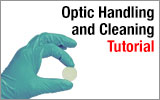
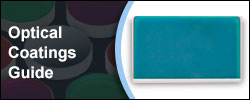
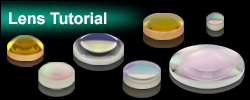
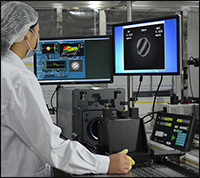 Click to Enlarge
Click to Enlarge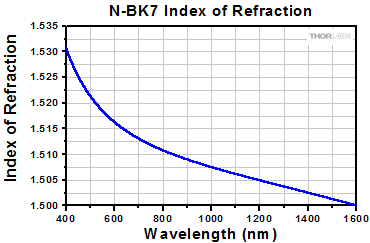
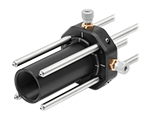
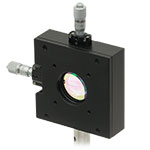


 N-BK7平凸レンズコーティング無し
N-BK7平凸レンズコーティング無し